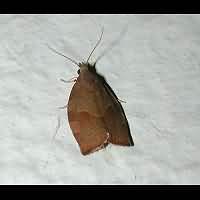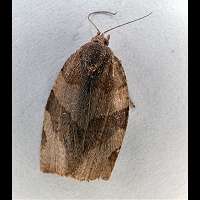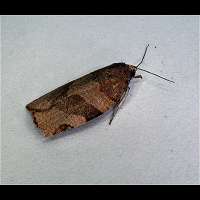Dark Fruit Tortrix (Pandemis heparana)
The Dark Fruit Tortrix, also known as the Willow Tortricid and the Apple Brown Tortrix, is another species belonging to the brownish group of Tortrixes. The brownish colours are darker than in relatives and the darker band on the wings is usually very well established. It lacks the fine lines of some other species, such as the Chequered Fruit-tree Tortrix. The underwings are greyish brown. Snout, antennae and legs are greyish white and unmarked. Reaching a wingspan of 16 to 24 mm it is a typically sized Tortrix. Females and males are similar, except for the size: the females are usually bigger than the males are.Vrouwtjes en mannetjes zijn nagenoeg gelijk, alleen is het vrouwtje wat groter dan het mannetje. variable species, like most other Acleris species.
The flat and oval eggs are deposited on leaves in batches of some 40 pieces, usually on the underside of the leaves. They hatch in 2 to 4 weeks. Then appear small larvae. They will eat for some time, spin a retreat on a twig or on the stem of the foodplant and hibernate. They awaken in May and eat of young leafs or shoots. They reach a length of 25 mm tops. They are a kind of pale green with white markings on the sides and the head is yellowish green with a few white lines. They pupate from June on near the top of the infested shoots, usually between leaves. The pupa is dark brown or even almost black and up to 17 mm long. The adults appear from the end of May to the beginning of October. The larvae live on a great variety of trees and bushes, including apple, pear, plum and currant. They may be very harmful in agriculture. Not because of the damage caused in spring to fresh leaves, but because the young caterpillars often nibble on growing fruit, resulting in misgrow, fungus infections or making the fruit extremely unattractive. Even more so, because this species often appears in great numbers in late summer and autumn, even though only a few larvae survive winter.
The pheromone is known and used to lure the animal. It also suffers from several parasitic flies and wasps. We do not know though, whether one of these is used commercially. Very common species in Europe, including the British Isles, the Middle East, Northern Asia, China, Korea and Japan. Has been found in the USA and is considered being an agressive invader.
The Dark Fruit Tortrix, also known as the Willow Tortricid and the Apple Brown Tortrix, is another species belonging to the brownish group of Tortrixes. The brownish colours are darker than in relatives and the darker band on the wings is usually very well established. It lacks the fine lines of some other species, such as the Chequered Fruit-tree Tortrix. The underwings are greyish brown. Snout, antennae and legs are greyish white and unmarked. Reaching a wingspan of 16 to 24 mm it is a typically sized Tortrix. Females and males are similar, except for the size: the females are usually bigger than the males are.Vrouwtjes en mannetjes zijn nagenoeg gelijk, alleen is het vrouwtje wat groter dan het mannetje. variable species, like most other Acleris species.
The flat and oval eggs are deposited on leaves in batches of some 40 pieces, usually on the underside of the leaves. They hatch in 2 to 4 weeks. Then appear small larvae. They will eat for some time, spin a retreat on a twig or on the stem of the foodplant and hibernate. They awaken in May and eat of young leafs or shoots. They reach a length of 25 mm tops. They are a kind of pale green with white markings on the sides and the head is yellowish green with a few white lines. They pupate from June on near the top of the infested shoots, usually between leaves. The pupa is dark brown or even almost black and up to 17 mm long. The adults appear from the end of May to the beginning of October. The larvae live on a great variety of trees and bushes, including apple, pear, plum and currant. They may be very harmful in agriculture. Not because of the damage caused in spring to fresh leaves, but because the young caterpillars often nibble on growing fruit, resulting in misgrow, fungus infections or making the fruit extremely unattractive. Even more so, because this species often appears in great numbers in late summer and autumn, even though only a few larvae survive winter.
The pheromone is known and used to lure the animal. It also suffers from several parasitic flies and wasps. We do not know though, whether one of these is used commercially. Very common species in Europe, including the British Isles, the Middle East, Northern Asia, China, Korea and Japan. Has been found in the USA and is considered being an agressive invader.






